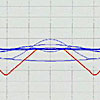-

-
Courses
Find courses by:
Collections
Cross-Disciplinary Topic Lists
- About
- Donate
- Featured Sites

 |
|
By the end of this lecture, you should:
› View/hide answer
The first step actually is analysis, which means breaking something down into parts. Operations such as \[{A_m} = \tfrac{1}{L}\int_0^{2L} {f(x)\cos \tfrac{{mx\pi }}{L}dx}\] provide "parts" from which the function is made when viewed as a Fourier series. Formation of the Fourier series is actually synthesis, or building up, of a function. The general form\[f(x) = \tfrac{{{A_0}}}{2} + \sum\limits_{m = 1}^\infty {{A_m}\cos mx} + \sum\limits_{m = 1}^\infty {{B_m}\sin mx} \]puts the pieces back together to rebuild the function from the coefficients.
› View/hide answer
A display of light spread out by wavelength is another way of spreading it out by frequency (it just happens that optical tools usually more naturally work with wavelengths). Similarly, a Fourier synthesis incorporates strengths (the A and B coefficients’ values) at different frequencies since each m corresponds to a harmonic term m times the fundamental. A major difference is that the light display is continuous while only discrete frequencies are possible in the Fourier analysis. However, it can be helpful to think, carefully, of the Fourier coefficients giving a "spectrum". If a body can move in many normal modes, and for a given motion one of the coefficients is larger than the others, the "spectrum" would let you know that that is the dominant mode for that given motion.
› View/hide answer
Strictly speaking, no. The general form \[f(x) = \tfrac{{{A_0}}}{2} + \sum\limits_{m = 1}^\infty {{A_m}\cos \tfrac{{mx\pi }}{L}} + \sum\limits_{m = 1}^\infty {{B_m}\sin \tfrac{{mx\pi }}{L}}\]is for functions with period 2L and is itself a periodic function with that period. Since the Gaussian pulse is not periodic, it cannot be analyzed. There may be circumstances where the tools could be applied to a periodic extension of the signal, and give some information, but this would need to be done with care.